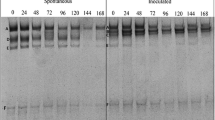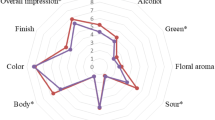Summary
Cachaça (sugarcane wine) was produced using different yeast strains, six being strains of Saccharomyces cerevisiae and one each of Candida apicola, Hanseniaspora occidentalis, Pichia subpelliculosa and Schizosaccharomyces pombe. The ethanol yields (%) of the non-Saccharomyces strains were similar to those of the Saccharomyces strains. The following determinations were carried out on the cachaça: acetaldehyde, ethyl acetate, propanol, isobutyl alcohol, isoamyl alcohol, volatile acidity. The cachaças showed variations in the levels of secondary compounds, but these variations did not result in differences (P ≤ 0.05) in the sensory attributes of aroma and flavour and overall impression. Of the volatile compounds quantified in the cachaças, only propanol showed a positive correlation (P ≤ 0.05) with the flavour attributes and overall impression. The S. pombe strain was considered inadequate for the production of cachaça. The cachaças were classified into five groups in an exploratory Hierarchical Cluster Analysis as a function of the volatile compounds. Principal Component Analysis showed that 93% of the variation (PC 1) occurred among the samples, and was explained by the individual volatile compounds and the total secondary compounds, with the exception of isoamyl alcohol only 7% (PC 2) was associated with the volatile acidity. The negative correlations shown between the volatile compounds of the cachaças and the ethanol content of the sugarcane wine, with the exception of acetaldehyde, showed that the variation in ethanol content of the sugarcane wine is an important factor for standardization of the ethanol/volatiles ratio and the beverage quality.
Similar content being viewed by others
References
Berry D.R. (1995) Alcoholic beverage fermentations. In Fermented Beverage Production, 1st edn., eds. Lea, A.G.H., Piggott, J.R. pp. 32–44. London: Blackie Academic & Professional. ISBN 0751400270
M. Bonneu M. Crouzet M. Urdaci M. Aigle (1991) ArticleTitleDirect selection of yeast mutants with reduced viability on plates by erythrosine B. staining Analytical Biochemistry. 193 225–230 Occurrence Handle10.1016/0003-2697(91)90013-J Occurrence Handle1714683
Y. Boza J. Horii (1998) ArticleTitleInfluência da destilação sobre a composição e a qualidade sensorial da aguardente de cana-de-açúcar Ciência e Tecnologia de Alimentos. 18 391–396
Brasil Portaria no 371 de 18 de setembro de 1974 do Ministério da Agricultura Pecuária e Abastecimento. Complementação dos padrões de identidade e qualidade para destilados alcoólicos. Diário Oficial da União, Seção I, Parte I, Suplemento, Brasília, 19 set. 1974, pp. 53–62
Brasil Decreto no 2.314 do Ministério da Agricultura Pecuária e Abastecimento de 04 de setembro de (1997). Dispõe sobre o registro, classificação, padronização, produção e fiscalização das bebidas. Diário Oficial da União, Brasília, 05 de set. 1997
Brasil. Decreto no. 4.851 do Ministério da Agricultura Pecuária e Abastecimento de 2 de outubro de (2003). Altera dispositivos do Regulamento aprovado pelo Decreto n. 2.314, de 4 de setembro de 1997, que dispõe sobre a padronização, a classificação, o registro, a inspeção, a produção e a fiscalização. Diário Oficial da União, Brasília, 3 out. 2003
H.M.A.B. Cardello J.B. Faria (1998) ArticleTitleAnálise descritiva quantitativa da aguardente de cana durante o envelhecimento em tonel de carvalho (Quercus alba L.) Ciência e Tecnologia de Alimentos 18 169–175
Cole V.C., Noble A.C. (1995) Flavor chemistry and assessment. In Fermented Beverage Production, 1st edn., eds. Lea, A.G.H., Piggott, J.R. pp. 361–385. London: Blackie Academic & Professional. ISBN 0751400270
L. Fahrasmane A. Parfait P. Galzy (1986) ArticleTitleProprietes fermentaires des levures de rhumerie Industries Alimentaires Agricoles 103 125–127
Lehtonen, M., Jounela-Eriksson, P. (1983) Volatile and non-volatile compounds in the flavour of alcoholic beverages. In Flavour of Distilled Beverages: Origin and Development, ed. Piggott, J.R. pp. 64–78. Florida: Verlag Chemie International Inc. ISBN 0–89573–131–2
Oliveira, E.S. (2001) Características fermentativas, formação de compostos voláteis; e qualidade da aguardente de cana obtida por linhagens de leveduras isoladas de destilarias artesanais . Tese de doutorado, UNICAMP, Faculdade de Engenharia de Alimentos, Campinas, Brasil
E.S. Oliveira C.A. Rosa M.A. Morgano G.E. Serra (2004) ArticleTitleFermentation characteristics as criteria for selection of cachaça yeast World Journal of Microbiology and Biotechnology 20 19–24 Occurrence Handle10.1023/B:WIBI.0000013286.30695.4e
A. Parfait C. Jouret (1975) ArticleTitleFormation of higher alcohols in rum Annales de Technologie Agricole 24 421–36
Pirouette. (1997) Multivariate Data Analysis for IBM PS Systems, Version 2.1, Infometrix, Seattle WA USA
Ribeiro, C. A. F. (1997) Potencialidades de diferentes linhagens de levedura da espécie Saccharomyces cerevisiae na tecnologia de aguardente de cana . Dissertação de mestrado, USP, Escola Superior de Agricultura ‘Luiz de Queiroz’, Piracicaba, Brasil
SAS Institute (1993) SAS User’s Guide: Statistics. Cary, USA ISBN 1555445543
D.D. Singer (1966) ArticleTitleThe analysis and composition of potable spirits: Determination of C3, C4 and C5 alcohols in whisky and brandy by direct gas chromatography Analyst. 91 127–134 Occurrence Handle10.1039/an9669100127
Stone H., Sidel J.L. (1993) Sensory Evaluation Pratices, 2nd edn. San Diego: Academic Press Inc., Serie (Food Science and Technology). ISBN 0-12-672482-2
H. Suomalainen M. Lehtonen (1979) ArticleTitleThe production of aroma compounds by yeast Journal of the Institute of Brewing 85 149–156
Vargas E.A. (1995) Qualidade da aguardente de cana produzida, engarrafada e/ou comercializada em Minas Gerais . Dissertação de mestrado, UFMG, Faculdade de Farmácia, Belo Horizonte, Brasil
H.W. Zimmermann (1963) ArticleTitleStudies on the dichromate method of alcohol determination American Journal of Enology and Viticulture 14 205–213
Author information
Authors and Affiliations
Corresponding author
Rights and permissions
About this article
Cite this article
Oliveira, E.S., Cardello, H.M.A.B., Jeronimo, E.M. et al. The influence of different yeasts on the fermentation, composition and sensory quality of cachaça. World J Microbiol Biotechnol 21, 707–715 (2005). https://doi.org/10.1007/s11274-004-4490-4
Issue Date:
DOI: https://doi.org/10.1007/s11274-004-4490-4




